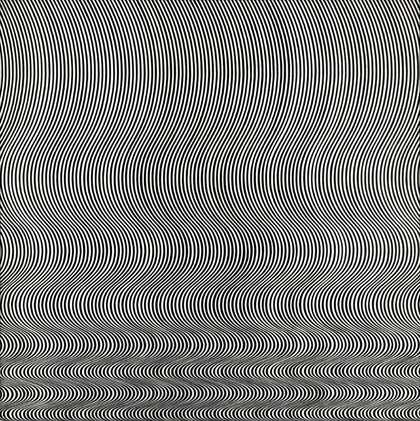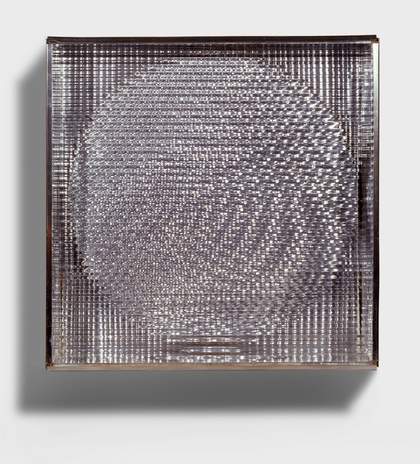Sue Fuller was enthused by the use of string in the art of non-Western cultures but believed that string art needed to be adapted to twentieth-century America. In 1954 she wrote: ‘Inspired by the engineering genius of our times and civilization, expressed in transparency, light and balance, I found the form of lineal geometric progression more significant for this extension of thought … though I fully appreciated the products of the engineer – airplanes, bridges, skyscrapers – mere representation of these symbols was not enough’.1 This passage brings to mind the words of critic John Canaday in his review of The Responsive Eye, an exhibition of op art at New York’s Museum of Modern Art in 1965. Writing more than a decade after Fuller, he asserted that the works on show were ‘the only objects being created today, as art, that can compete with launching pads and industrial machinery as expressions of the character unique to our civilization’.2
Fuller collaborated with manufacturers to produce the polypropylene ‘fishing-line’ monofilament she used, and obtained a US patent on the process by which she constructed her work.3 All of this suggests her commitment to ‘the engineering genius of our times and civilization’. She was concerned with the longevity of the work she produced: ‘I really feel … if your work is going to be found in a museum, the museum should have the guarantee that you’ve done your best to make it permanent’.4 Her collaborations with industry were part of her quest to achieve this ‘permanent’ result by developing technically advanced materials that would last. With Canaday’s words in mind, Fuller’s work would seem to be a perfect match for The Responsive Eye, the largest exhibition of op art held in the 1960s, featuring over 120 works by ninety-nine artists from fifteen countries. Indeed, Fuller’s String Composition 119 1964 (whereabouts unknown) was included in the exhibition and was described by critic Henry Seldis as ‘a jewel of a construction’.5 But it did not generate the kind of critical engagement afforded to, say, Bridget Riley’s work, perhaps because it was not as easy to relate to other op artworks.
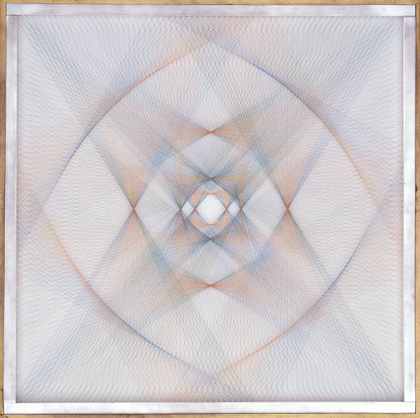
Fig.1
Sue Fuller
String Composition 128 1964
Plastic threads, wood, fabric and metal
914 x 914 x 38 mm
Tate T00757
© reserved
Some contemporary commentators did describe Fuller’s work as having optical effects. In 1965 one critic described Fuller’s string constructions as ‘an off-shoot of the present vogue of Op Art’ and suggested that ‘by viewing from different angles varied effects are produced’.6 Emerson Crocker, who was instrumental in bringing String Composition 128 (fig.1) into Tate’s collection, listed the following optical qualities of Fuller’s art in 1966: ‘the magical perspectives, the soaring perpendiculars, the plunging arcs, the dizzying swoops and turns, the practiced deceptions of space and volume, the melodic lines mysteriously vanishing before the incredulous eye’.7 Writing over a decade later, the critic David Shirley claimed:
It is impossible to experience a work of Miss Fuller’s and remain in one spot with the eyes fixed on one focal point. We must move around, changing the positions of our eyes, readjusting our focus, craning our necks, stooping and generally going through a mild repertory of gymnastics. Never can these constructions be seen twice in the same way. A different light and a different body add up to a different visual perception.8
Fuller, however, did not position herself as an op artist, and nor did Rosalind Browne, who wrote a detailed and enthusiastic article about Fuller in Art International in 1972. In her own account of her work, published in Craft Horizons in 1954, Fuller writes about the influence of Josef and Anni Albers and the Bauhaus, and earlier European artists including Cézanne, Cassatt, Gainsborough and Picasso, among others. Yet neither Fuller nor Browne mentions contemporaries such as Victor Vasarely, Bridget Riley or other artists known later for their op work. If one considers art that was unequivocally regarded as op – such as Bridget Riley’s Fall 1963 (fig.2; an image closely related to Current 1964, which generated a lot of attention at The Responsive Eye), or Jean-Pierre Yvaral’s Kinetic Relief–Optical Acceleration 1963 and Heinz Mack’s Light Dynamo 1963 (fig.3) – there is an immediate contrast between the very noticeable optical activity of these very different works and that of Fuller’s.
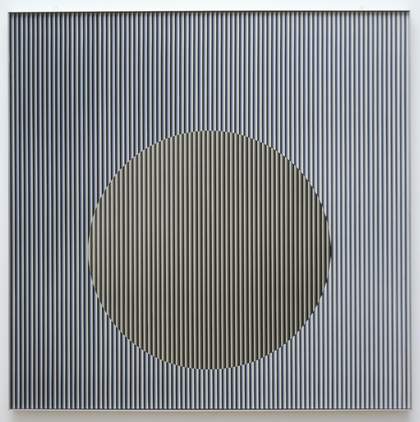
Fig.4
Carlos Cruz-Diez
Physichromie No.113 1963, reconstructed 1976
Painted aluminium and stainless steel
1000 x 1000 mm
Tate T02094
© ADAGP, Paris and DACS, London 2018
So was Fuller’s string work ‘op’ enough to be considered ‘op art’? The present location of String Composition 119 is unknown, so it would be useful to examine Tate’s String Composition 128, also made in 1964. While most of the exhibits in The Responsive Eye seem to have been paintings, three-dimensional constructions were not uncommon among op artworks more generally.9 In contrast with kinetic artworks, which actually move or have moving parts, three-dimensional op artworks rely on the movement of the viewer and parallax effects or colour changes to induce a sense of dynamism. The ‘physichromie’ series by Carlos Cruz-Diez, of which Tate has two examples – Physichromie No.113 1963, reconstructed 1976 (fig.4) and Physichromie No.123 1964 – explore such effects. In the case of String Composition 128, no such impressions are apparent. The strings of fine, delicately coloured monofilament give a surprisingly vibrant effect, not conveyed by photographs, but the depth of the work is far too shallow to present different effects as one moves past it. There is no sense of optical illusion or that one’s perceptual apparatus is being manipulated in any way. The only mildly illusory or optical effect is that although constructed of taut, straight filaments, the composition appears to be a pattern of curves.
Given the large amount of publicity afforded to The Responsive Eye by mainstream publications such as Time and the New York Times, which emphasised the ‘op’ aspects of the show, most people visiting the Museum of Modern Art (or other venues when the show later toured the country) must have expected to see art that would be strongly characterised by optical effects. One article published just months before the exhibition opened was titled ‘Op Art: Pictures that Attack the Eye’.10 An Art News review of the show was titled ‘You Can Hang it in the Hall’, implying that the works were too visually disturbing to hang anywhere where one would spend much time looking at them.11 That article made much of the visual disturbances one might expect and mentioned that the effects had been compared to those of LSD, which at that time was still a legal, if controversial, substance.
Notwithstanding the comments by Crocker and Shirley quoted above, it would seem that visitors who expected such effects would not have found them in String Composition 119. As British critic Robert Melville put it in 1964: ‘it’s very easy to tell the failures [among op art paintings] – their surfaces don’t heave or twitch or quiver or oscillate’.12 While this is a rather sweeping characterisation of op art, it probably does reflect a wide understanding of what this kind of work should involve. The press generally emphasised the sensational aspects of the show and so Seldis’s praise of Fuller’s ‘jewel of a construction’ appears to be the only mention of String Composition 119 in reviews of the exhibition.
Why was Fuller’s String Composition 119, an apparently similar work to String Composition 128, included in The Responsive Eye? There is a natural inference that Fuller’s work was included in the exhibition because it was deemed to be op art; after all, the show was usually described as an op art exhibition.13 Nonetheless, on the first page of the exhibition’s catalogue, the curator William B. Seitz states: ‘The work of some of the artists represented in this exhibition has been labeled “optical” or “retinal”’. By implication, then, there were other works on show that had not been given these labels. Instead of defining his artists and their work in relation to op art, Seitz referred to them as ‘perceptual artists’ – a category that might seem almost infinitely elastic – and borrowed for them a definition of the impressionist artists coined by poet Jules Laforgue in 1883: ‘modernist painter[s] endowed with an uncommon sensibility of the eye’.14
In her review of the exhibition, critic Barbara Rose wrote that ‘the Museum of Modern Art has housed together in one amorphous (and hence relatively meaningless) category, examples of nearly every kind of non-painterly painting done in the West since the war’.15 She categorised the works on show into three groups: products of ‘various European visual research groups’; ‘purist painting … by the legitimate heirs of the Bauhaus tradition’, and ‘post-painterly abstraction’. She also noted ‘some glass, plastic and metal objects, descendants of Constructivist and neo-Plastic sculpture’ but did not relate these to her categories.16 Fuller’s String Composition 119, and indeed Tate’s String Composition 128, would seem to fit among the unclassified ‘descendants of Constructivist and neo-Plastic sculpture’.
Rose, a critic influenced by the Kantian ideas promoted by Clement Greenberg, then the most influential figure in the post-war art world, was scathing about ‘European Op’ in her review of The Responsive Eye’s New York showing. For Rose, a work could not be both ‘important’ and ‘op’. She wrote: ‘In many ways the European art seemed like a showcase for the American work which by contrast shone like so many diamonds in a field of synthetic brilliants’.17 Rose mentioned a number of American artists, notably Larry Poons, Kenneth Noland, Jules Olitski, Paul Brach, Alexander Liberman, Paul Feeley and Gene Davis, whose work, for her, constituted ‘important painting’, and was therefore not ‘op art’.18 She referred approvingly to an earlier review by another critic in her circle, Sidney Tillim, in which he had divided op into ‘European type’ (bad) and ‘American type’ (good).19 Rose noted that Tillim, who did not mention Fuller’s work either, had ‘already done such an adequate job of demonstrating that optical art is the last wing of the Bauhaus’.20 This reference to the Bauhaus art school suggests that anything with connections to constructivism, a form of art that originated in Soviet Russia and developed at the Bauhaus in Germany between the wars, could not be deemed by Rose or Tillim to be good, American art. At the height of the Cold War, the nationalistic terms used by Rose and Tillim to distinguish between different tendencies in art had overt political connotations.
For her part, Fuller was undoubtedly very interested in and influenced by a number of European artists with whom she initially had contact via British artist Stanley William Hayter’s Atelier 17 in New York. Atelier 17 was initially a Paris-based workshop that Hayter transferred to the USA at the outbreak of the Second World War. What seems to have influenced Fuller the most were the ideas of constructivist artists for whom purity of form was more important than notions of self-expression. This implicitly allies her constructions with ‘European-type’ op art and may have contributed to US critics’ lack of engagement with her work – it simply may not have seemed American enough to some of them. This relationship with constructivism may well, however, have had a bearing on Tate’s acquisition of String Composition 128.
Fuller’s String Composition 128 entered Tate’s collection in 1965. It was donated via the Friends of the Tate but given to the Friends by an American collector, Emerson Crocker. A major museum such as Tate does not accept everything that is offered, so it can be assumed that this work was actively desired by the museum and that the Friends had negotiated the gift with Crocker in light of this.
Negotiations between Crocker, Tate’s acquisitions committee, the Friends and the American Federation of Arts (an intermediary used by Crocker for tax reasons) took some time. They had actually started at least by November of the previous year, 1964, as a letter to Emerson Crocker from Norman Reid, then the Director of the Tate Gallery who had a seat on the Council of the Friends, reveals.21 Given the length of time it took to set up The Responsive Eye, by November 1964 it must have been known to all the parties that Fuller would be represented in that exhibition, which from the outset was planned to be the most important show of perceptual art yet mounted.22
So, the work that Tate wanted was by an American artist about to be shown in a blockbuster exhibition featuring work by an international roster of artists. Fuller had attracted favourable comment in the US art press, even if, as we have seen, much of it was not of a very detailed nature. In one newspaper article about a school trip to New York, for which Fuller gave a talk, she is described as ‘one of the most famous of the modern painters’.23 She had received fellowships from the Guggenheim and Tiffany foundations and had undertaken teaching work at several respected institutions, including the Museum of Modern Art.24 Crocker, an established patron of the arts, was offering the work concerned.25 All in all, Fuller must have looked like a rising star – but this was surely not enough by itself to make a work by her fit some perceived gap in the Tate’s collection. Arguably, that gap had been created by the British art establishment’s relationship to modern art movements in the years immediately following the Second World War.
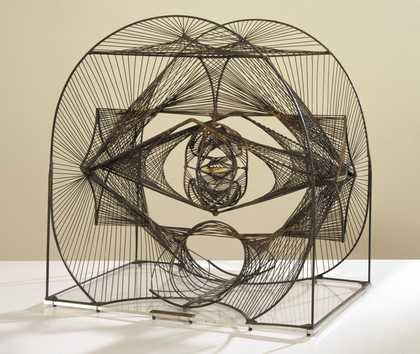
Fig.5
Antoine Pevsner
Maquette of a Monument Symbolising the Liberation of the Spirit 1952
Bronze
472 x 465 x 310 mm
Tate N06162
© ADAGP, Paris and DACS, London 2018
While leading figures in the British art world, such as Kenneth Clark, had been giving prominence to the work of neo-romantic painters such as John Minton, Ivon Hitchens and Keith Vaughan, another very different type of art was developing. During the 1950s and 1960s a loose grouping of artists in England ‘shared a commitment to a non-figurative art that was not abstracted from the appearance of nature but constructed from within and built up of balanced relations of clear, geometric forms’.26 American theorist Charles Biederman coined the term ‘constructionist’ to distinguish this new abstract art from earlier Russian constructivism.27 Nonetheless, there are connections between the two and constructionist works are clearly related to earlier European art. One can certainly see a clear connection between the constructivist Antoine Pevsner’s late work Maquette of a Monument Symbolising the Liberation of the Spirit 1952 (fig.5), purchased by Tate in 1953, and Fuller’s string constructions.
In the face of the overwhelming success of abstract expressionism, it was plain by the 1960s that abstraction had become the important modernist tendency of the day. Much British art had followed the lead of the first European post-war abstract artists and op art began its rise to international ascendancy. As British art critic David Thompson put it in 1964: ‘British art in particular has suddenly woken up out of a long provincial doze, is seriously entering the international lists and winning prestige for itself’.28
Constructionist work created by the artists who had pursued such interests since the early 1950s, often hitherto ignored by public institutions, started to be bought for national collections. Kenneth Martin’s Small Screw Mobile 1953 was purchased by the Tate in 1962; Mary Martin’s Spiral Movement 1951 followed in 1963; Anthony Hill’s Relief Construction 1960–2 was also purchased in 1963. Works by these artists and other constructionists continued to be purchased or accepted as gifts throughout the 1960s and into the twenty-first century.
Fuller’s String Composition 128, with its ties to the stringed work of Gabo, Pevsner, Moore and Hepworth, and to the Martins and their constructionist associates, may have been seen as evidence of the enduring relevance of Anglo-European abstract art. That it was created by an American artist – one who claimed to have been influenced by ‘Gainsborough, Cotman, Mary Cassatt, Kathe Kollwitz, Picasso, Hayter’ and whose work was to be included in The Responsive Eye – must only have served to endorse this belief.29
String Composition 128 was still being presented as op art in 1967, when curator Michael Compton’s book Optical and Kinetic Art was published by Tate. The work was reproduced in the book opposite a work by Vasarely but scant mention of it was made in the text. Despite detailed comments on other works illustrated, the only mention of the Fuller work is: ‘In [Naum Gabo’s] “Linear Construction in Space” the plastic threads form tangents which are integrated into secondary curves (also seen in Sue Fuller’s “String Composition”).’30 Its inclusion in the book suggests that Tate regarded Fuller’s work as op art, presumably because of the showing of a related work at The Responsive Eye, although Compton clearly struggled to discuss it as such.
The association with op art does not appear to have been sought by Fuller, and as is argued above, does not aid our understanding of it. It is better regarded as a work of geometrical constructionist art informed by a variety of influences, both American and European. It entered Tate’s collection at a time when the British art establishment felt that at long last British artistic traditions were gaining international recognition. Fuller’s work could be seen as evidence of that impact on an apparently rising star of the US art world and this, perhaps, was the impetus behind the acquisition of String Composition 128. For Fuller herself, given the apparent determination of some influential critics to promote US geometric art at the expense of foreign versions, the same connections that recommended her to the buyers at Tate may have made her work seem less American at home than that of Larry Poons, Kenneth Noland, Jules Olitski and other contemporaries whose work also appeared in The Responsive Eye. The number of her works in US museums and the honours she received in her lifetime attest to the precision and craftsmanship of her work, but at a time when the international political landscape was dominated by the Cold War, European influences that could be traced back to Russian constructivism were probably bound to be problematic. Perhaps now her work can be viewed more dispassionately and take its place among the geometric abstraction that formed such a decisive break with the abstract expressionism that had preceded it.

